
Olhão is a low-key fishing town in the Algarve with flat-roofed “cubist” houses, working boats in the marina and ferries sliding out to Ilha da Armona. Living in Olhão means you get proper year-round town living here rather than a manicured resort. The old lanes are walkable and social, sunsets over the salt pans are a minor addiction, and nature is on the doorstep.
What's it like living in Olhão?
Without doubt, one of the most beautiful fishing villages in the Algarve, its twin red-brick market anchors daily life on the waterfront. You can enjoy grilling sardines at lunchtime and a lively Saturday produce rush. You get a slower pace, sea air, and prices that feel gentler than the resorty west.
Where is Olhão and who moves here?
Set in the eastern Algarve between Faro and Tavira, Olhão sits on the regional Linha do Algarve rail line and the N125. You have quick access to the A22 for zipping along the coast, and you're just 15–20 minutes east of Faro airport.
Alongside long-standing local families connected to fishing and services, you’ll meet northern Europeans—Brits, Germans, Dutch—plus Portuguese returnees and a growing remote-work crowd drawn by fibre internet and the airport link.
Is Olhão safe to live?
Overall, Olhão feels safe and neighbourly, with the usual Algarve caveats in peak summer. Petty theft can crop up around the waterfront, markets and transport hubs when it’s busy, and the port’s industrial edges can feel a bit rough late at night.

Pros and cons of living in Olhão
Life in Olhão comes with plenty of perks and a few quirks you’ll want to note.
Some of the pros of life in Olhão include:
- Easy access to nature: ferries to car-free Ilha da Armona, Ilha da Culatra and Farol, plus the Ria Formosa for kayaking and birdwatching.
- Good value for the Algarve: everyday costs feel gentler than the resort towns, with fresh seafood at the market.
- Convenience without the sprawl: a walkable centre, regional trains to Faro and Tavira, and a short hop to Faro Airport.
A couple of cons to be aware of:
- Limited big-city services in town: for private hospitals, larger shopping centres and most international schools, people head to Faro, Loulé or Almancil.
- Summer pinch points: crowded waterfront and ferry queues, plus older homes that may need renovation and better insulation.
Cost of living in Olhão
Day-to-day costs in Olhão are manageable on a modest budget and can be more realistic than living in other areas of the Algarve. A couple can live comfortably on €2,200–€2,500 per month, excluding rent. Eating out is reasonable: a cheap main course is about €15, a mid-range meal for two around €55, a beer out roughly €2.50, and a cappuccino or coffee near €2. A monthly gym membership is about €40, and basic utilities for an 85 m² flat tend to land between €100 and €150 per month.
As for housing, property prices in Olhão averaged around €3,062 per m² in October 2025, notably lower than Albufeira at €3,870 and Lagos at €4,410. If you're looking to rent an apartment in Olhão, prices start from around €1,000 per month.

Best areas and where to live in Olhão
The centre of Olhão hugs the waterfront, while roomier options sit in the parishes just inland. It’s a compact place, so you can mix town life with easy escapes to the islands.
Centre and waterfront: historic lanes, flat-roofed houses and modern blocks near the marina.
West side – Bairro da Barreta: old fishermen’s quarter with narrow streets and character homes.
East side – Bairro do Levante: straightforward grid, handy for shops and services.
Quelfes: suburban and practical with townhouses, newer apartments and supermarkets, this area is one of the cheapest places to buy property in the Algarve.
Pechão: inland village feel with detached homes and plots.
Fuseta: low-rise, sandy lagoon beach and a small train station. Popular for holiday lets near the water and year-round living, a stop or two from Tavira and Faro.
Moncarapacho: countryside base with quick access to the coast.

Living in Olhão as a foreigner
Life as a newcomer in Olhão is easy-going once you get the basics sorted. Migration matters now run through AIMA, and popular residence routes include work-based permits and the D8 digital nomad visa. Day to day, English gets you far in shops and along the waterfront, but a bit of Portuguese helps with bureaucracy and trades, and locals appreciate the effort.
Community-wise, it’s a sociable town: you’ll find language exchanges, paddle and sailing groups on the marina, and plenty of expats spread between the towns. The rhythm is year-round rather than stop–start resort living, markets anchor the week, and ferries to the islands make weekends feel like mini holidays without the faff.
Schools and healthcare
Families tend to mix local state schools in town with international options a short drive away. The closest international curricula are at Colégio Internacional de Vilamoura (CIV), Nobel Algarve British International School and Eupheus International School. For higher education, the University of the Algarve (UAlg) is over in Faro.
Healthcare is straightforward: there’s a public health centre and clinics in Olhão, while major public hospital care is at Hospital de Faro. For private treatment, many use Hospital Particular do Algarve (HPA) Gambelas, alongside other reputable private providers.
Food, culture and free time
This is seafood country. The Mercado Municipal de Olhão is the daily hub for fish and produce, and you’ll eat well at no-frills grills like Restaurante Vai e Volta, market bars serving petiscos, and island beach cafés. Summer brings the Festival do Marisco, while smaller concerts and saints’ days keep the calendar ticking.
Outdoorsy types do well here: kayaking or SUP in the lagoon, birdwatching at Quinta de Marim, long walks by the salt pans at golden hour, and easy ferry hops.
Stay in the know about living in Portugal as a foreigner—get our weekly newsletter for the latest travel, legal, and lifestyle news.





